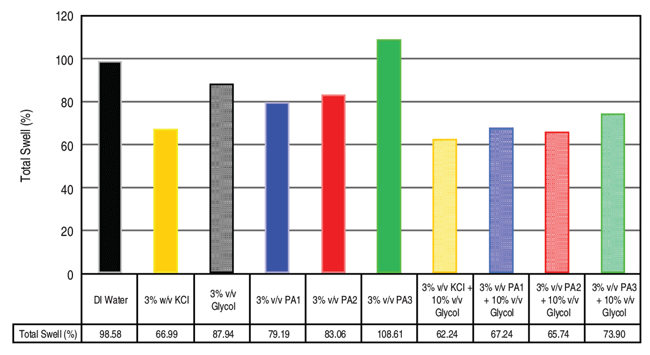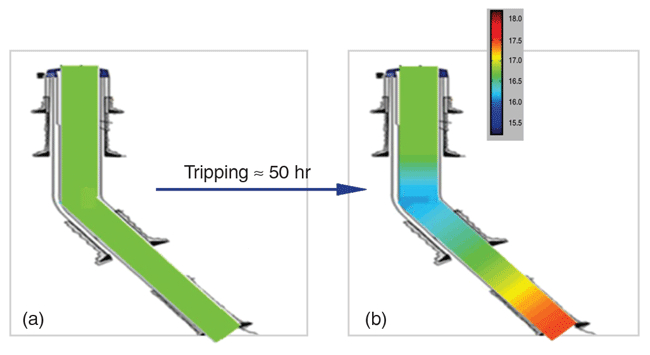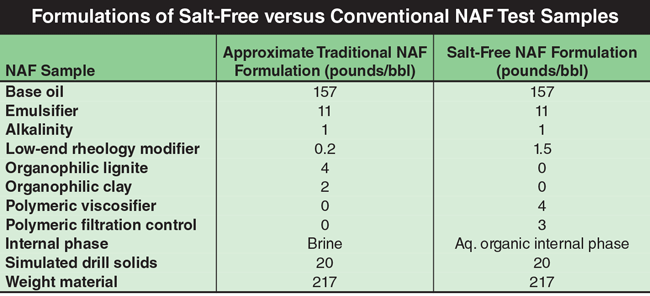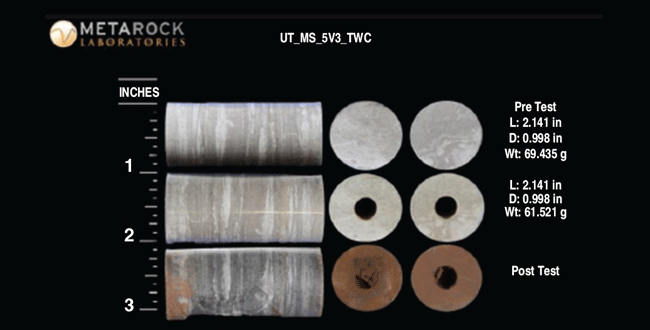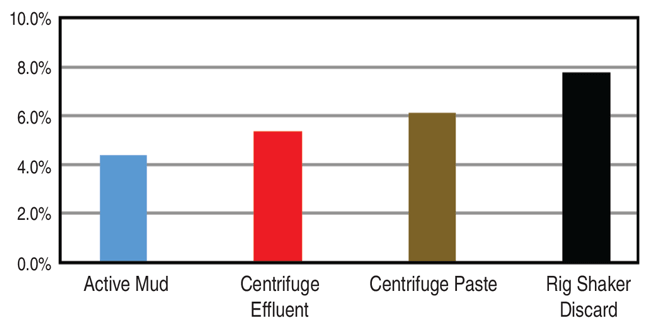
Incremental Advances Maintain Momentum Of Fluids Technology
By Ryen Caenn
LAGUNA BEACH, CA.–A number of cutting-edge drilling fluid technologies have been introduced in recent years, including advanced water-based and nonaqueous-based systems, as well as novel solutions to enhance wellbore stability and prevent lost circulation.
Drilling fluids providers continue to develop technologies and practices to help operators optimize drilling performance, mitigate environmental impacts, and streamline drilling economics. New fluid chemistries and additives–including formulations purpose-engineered for long horizontal and shale wells–closed-loop designs, regulatory requirements, total solids and waste control, and automated mud system management on the well site remain among the key drivers of research and development efforts.
Cost control continues to be a major criterion in all operational decisions, and fluid system selection is no exception.
A mud system’s per-barrel cost is not necessarily the best measure. Choosing a more complex fluid system matched to a formation’s specific geology will cost more, but it also may eliminate formation damage and minimize problems that could turn into nonproductive-time events. For these reasons, the “cheapest” fluid may not have the lowest absolute cost when all factors are considered.
The fluids industry is continuing to maintain forward momentum by introducing incremental advances in fluid products, systems and applications. A cursory review of technical presentations at this year’s American Association of Drilling Engineers’ Fluids Technical Conference & Exhibition, and the International Association of Drilling Contractors/Society of Petroleum Engineers Drilling Conference & Exhibition, demonstrates several developments across a range of areas, including WBMs, NAFs, lost circulation materials, on-site operations, and automation.
Water-Based Fluids
Water-based muds are the systems of choice for onshore resource plays, and several high-performance WBM products for enhanced wellbore stability are now available. The base fluids for these formulations range from freshwater with very low chloride content to saturated brines. Using brines for mud weight control and clay inhibition are part of the makeup of high-performance WBMs.
Freshwater reacts with shale formations and can accelerate wellbore collapse. Brine-based systems and stabilizing additives slow the water-wetting of shales to improve stability. Brine-based systems typically eliminate the need to use bentonite for viscosity and fluid loss control, with water-dispersible polymers added to control API mud properties.
One of the more intriguing developments in WBMs is using polyamines as shale stabilizers in high-performance systems. Polyamines disperse readily in water and are known to stabilize clays when drilling through water-sensitive shales. At the AADE Conference, Newpark Drilling Fluids researchers presented the results of a study examining the relationship between the inhibitive properties of polyamine compounds and structural changes to clay substrates.
Newpark used X-ray diffraction (XRD), linear swell meter testing (LSMT), and dynamic particle-size imaging to study three types of polyamines:
- A linear, short-chain alkyl polyamine;
- An angled, short-chain polyamine; and
- A long-chain polyamine with modified functionality.
The focus of the work was to study changes to the clay substrates after they were treated with polyamines. The data collected included the effects of the polyamine on the bentonite crystalline structure and the effects on particle size distribution and shape factors.
Looking at the results of XRD measurements on sodium montmorillonite (Na-MMT) treated with different polyamines, the researchers concluded that the polyamines inserted themselves within the interstitial layers of Na-MMT in either a monolayer or dilayer arrangement, depending on their size.
XRD also demonstrated that structural shifts occurred in the Na-MMT when treated with polyamines. This structural shift had a strong correlation with the substrates’ swelling and dispersive behaviors, as measured by LSMT and dynamic particle-size analysis.
This approach potentially can predict the swelling inhibition capacity of a polyamine. “The link between all these techniques provides the potential to establish a new screening approach for shale inhibitor selection and a further understanding into polyamines’ inhibition mechanism,” Newpark’s Ezekeil Hudson II and Antoine Thuriere state in an AADE paper.
FIGURE 1
LSMT Pellet Swelling Results
Using Polyamines as Shale Stabilizers
Source: Hudson and Thuriere, AADE 2016
FIGURE 2
Uniform Fluid Weight Before Trip (Left)
And Segregated Weight after 50-Hour Trip (Right)
Source: Kulkarni, et. al., IADC/SPE 2016
Figure 1 shows some of the LSMT results. A pellet press included with the LSMT produces core plugs from ground Na-MMT. The plugs were immersed in 3 percent volume/volume concentration inhibitor solutions. The hydration of the clay was monitored over 24 hours. The increase in height of the core plug during the exposure period related directly to the level of interaction between the fluid and substrate.
Nonaqueous Fluids
Nonaqueous fluids (NAFs) remain the choice for offshore drilling. In deep water, drilling fluids are constructed exclusively with synthetics, typically an olefin or in some cases a low-toxicity mineral oil or esterified vegetable oil. Synthetics are preferred because they eliminate wellbore stability problems caused by shale water-wetting and minimize nonproductive time.
Weight material sag (barite particle settling) occurs during drilling operations when NAFs remain idle in the wellbore for an extended time at static or low-shear conditions. Fluid composition, fluid properties, well geometry, and borehole conditions also influence sag behavior.
Halliburton has developed a method for predicting real-time sag in the wellbore and the fluid mud weight collected at the surface as it is circulated out after a sag event. The method gives mud engineers a new tool for evaluating sag behavior, and could enable fast decision making at the rig site to optimize fluid formulations and operating conditions to manage sag.
In a paper presented at the 2016 IADC/SPE drilling conference, Sandeep Kulkarni, Dale Jamison and Joshua Gollapalli reported on the development of the comprehensive computational sag modeling approach using fluid composition/properties and wellbore geometry/conditions. Modeled predictions, especially mud weight variations in the fluid collected at the surface after a sag event, were validated successfully on several wells and fluid systems.
Figure 2 is an example output from the mathematical model showing a fluid mud weight profile after a 50-hour trip. In this example, the sag model estimates the surface mud weight of the fluid at bottoms-up (i.e., a lighter portion averaging 16 pounds/gallon followed by a heavier portion of 17.6 pounds/gallon).
NAFs typically contain high levels of salts in the internal phase of the emulsion to provide wellbore stabilization/osmotic control. Environmental concerns with disposing of oil-wet cuttings are well known, but chloride residue on cuttings resulting from calcium chloride or sodium chloride also pose cutting disposal issues. The salts do not biodegrade and high concentrations can accumulate in soils.
Accordingly, another Halliburton research initiative developed a salt-free NAF with the performance of a conventional NAF. It uses a biodegradable organic in place of chlorides to provide an internal phase with equivalent water activity to traditional salt-containing systems. The salt-free system was field validated in multiple wells in the Western Canadian Sedimentary Basin.
Jonathan Walker and his colleagues at Halliburton presented the results of this work at the IADC/SPE drilling conference. The salt-free NAF was initially laboratory tested. Two major components of the fluid are the biodegradable organic as the internal phase and a proprietary oil-based mud stabilizer. The stabilizer provides both suspension and filtration control in the fluid, and is necessary at higher temperatures to prevent sagging.
Table 1 shows the properties of the salt-free formulation used in the lab study compared with a traditional NAF containing chlorides.
The lab testing was followed by field trials on a seven-well pad in Alberta. Three of the wells were drilled with the salt-free NAF and the other four with a conventional invert emulsion fluid. The salt-free system performed the same as or better than the conventional fluids. Observed improvements over conventional NAFs included less fluid maintenance, greater inhibition of the formation, and less fluid loss (in part, resulting from reduced oil on cuttings).
Moreover, a bioremediation study to analyze cuttings from each well for electrical conductivity and plant growth showed that when mixed with topsoil, the salt-free cuttings allowed for viable plant growth while the conventional cuttings did not. The system ultimately reduces the cost and liability associated with using NAFs in many areas.
Stability, Lost Circulation
Various shale/fluid compatibility tests have been used to help select a WBM to stabilize the specific formation to be drilled. Scientists at the University of Texas at Austin have introduced a low-cost laboratory shale test for wellbore stability that provides results with the quality of more sophisticated and expensive protocols, such as downhole simulation cell testing.
The modified thick wall cylinder (TWC) test exposes cylindrical shale samples to mud formulations at overbalanced conditions under confined downhole temperature/pressure regimes. After a specified time, the failure strength of the sample is assessed. The new procedure is easier and more economical than other test methods. Moreover, it can be used for the comprehensive qualification of new nanoparticle and high-salinity fluid formulations.
Figure 3 shows photographs of cylindrical Mancos Shale samples before coring the 0.3-inch borehole, before TWC testing, and after TWC testing when collapse has occurred. The samples measure one inch in diameter.
There is significant industry interest in understanding the material properties of lost circulation materials (LCMs), including size degradation studies from mechanical compression tests and shear flow. These types of tests are particularly important in mature fields, which often require LCMs as background material.
Total E&P U.K. and Halliburton performed a flow loop test to study the size degradation of LCMs, mainly ground marble (GM) and resilient graphitic carbon (RGC). The flow loop test used flow rates and conditions selected on the basis of what would be encountered in the field. Predetermined amounts of GM and RGC were added to an 80-barrel synthetic fluid, and the fluid/LCM was circulated through the flow loop at a rate of 400-gallons/minute.
The flow loop testing demonstrated that RGC had excellent resistance to size degradation compared with GM and other LCMs such as calcium carbonate. The results obtained from the flow loop tests were in good agreement with data on size degradation of LCMs from laboratory-based testing, and show the importance of using a resilient LCM such as RGC as part of a background package when drilling lost-circulation problem zones in mature fields.
Retort Testing
In a presentation at the AADE conference, Cutpoint Inc.’s Mike Morgenthaler, Cenergy Engineering’s Weston Hinton, and Texas A&M University’s Lance Nace described a consistent and systematic error in API retort testing.
Accepted field practice is to report volumetric water, oil and solids based on the sample density measured prior to the start of the retort procedure. However, the researchers discovered that the API retort procedure and using volumetric data resulted in an error of ±4 percent for a drilling fluid. This error is caused by the loss of mass during the retort test run.
The missing mass is predominately from the liquid phase of the sample, and not the solid phase. Failure to capture and condense this missing liquid in the graduated cylinder causes measurement errors and results in reporting solids contents higher than actual.
A gravimetric method is proposed as an alternative retort procedure that can be used as a check on the API procedure and to correct the calculated results from the retort test. Figure 4 shows the average correction for retort data on different sample types.
From the test results, the study concluded that mass was always lost when a 50-milliliter retort was run, and that qualitative evidence pointed to water as the most likely constituent failing either to report to or condense in the graduated cylinder. In addition, the study found that low-gravity solids concentrations in drilling mud and cuttings likely were being over-reported because of the missing mass when empirical data from 50-ml retorts were reported accurately.
Further lab work must be undertaken to confirm the nature of the missing mass and establish a statistical basis for mathematically correcting empirical data so that low-gravity concentrations can be reported more accurately.
Fluids Automation
The days of manual fluid property analysis are disappearing rapidly. Next-generation measurement tools and techniques make it possible to carry out sophisticated drilling fluid analyses using automated equipment.
Recognizing the important role that automated particle size analyzers will play in future drilling operations, the University of Texas at Austin conducted a comprehensive experimental study of advanced particle size analyzers to investigate their utility for automated drilling fluid analysis.
The study used three devices that automatically determine particle sizes in a drilling fluid: an imaging microscope, a laser diffraction instrument, and a dynamic light-scattering instrument. The devices were deployed in conjunction with UT test facilities, including a flow loop and shearing device, to examine the particle size distribution of lost circulation and wellbore strengthening materials, and the behavior of emulsion droplet-size distribution of NAFs.
While the imaging microscope produced the most accurate results, it also was the most labor-intensive to operate, requiring an expert user. Simplification and automation of its operating procedure will need to happen before it can be deployed in field operations.
The laser diffraction equipment proved to be the most reliable, and exhibited excellent repeatability in the laboratory environment. However, it also required an expert user and manual labor to operate. In its current state, and without automation and in-line deployment, it also is not suitable for field deployment.
The focused beam reflectance measurement equipment proved easiest to operate and could work on opaque fluids with no dilution required. It also offered the ability to operate in a fully automated mode and to be applied in a field environment, as has been done on a limited trial basis. On the downside, its chord length approach with conversion to volume-weighted distribution proved to be the least accurate quantitatively, and was the most sensitive option to changes in the particle size of nonspherical materials.
The days of a single daily mud check, augmented with a few partial checks, also are a thing of the past, thanks to automated fluid rheology technology developed through another University of Texas at Austin research project.
This technology enables a practical automated approach with minimum maintenance efforts to continuously monitor drilling fluid rheological parameters at the rig site. Accurately measuring rheological properties is essential to optimizing wellbore construction and managing hydraulics. It becomes even more crucial in deepwater drilling, given the narrow mud windows, which may require advanced technologies such as managed pressure and dual-gradient drilling.
FIGURE 5
Pipe Viscometer Schematic
Source: Ali Karimi Vajargah, et. al., SPE 2016 Deepwater Drilling & Completions Conference
Central to the new approach is a device based on a pipe viscometer configuration (Figure 5) that continuously and automatically monitors rheological properties. Pressure loss is measured at several flow rates, which can be used to determine rheological properties. The device records the frictional pressure loss at multiple flow rates covering laminar and turbulent flow regimes.
The system’s reliability and robustness have been demonstrated through successful testing with different weighted and unweighted mud systems. Standard API rheological parameters are determined from the differential pressure data for laminar flow.
Automated, real-time viscometer measurement using the pipe viscometer approach represents a step-change improvement in mud monitoring and maintenance, while also improving rig safety and efficiency. The technology can significantly improve the ability to feed accurate rheological information in real time into sophisticated hydraulics models used to manage equivalent circulating densities, and may enable technologies such as managed pressure and dual-gradient drilling.

Ryen Caenn is principal of TekRite Communications, which has consulted oil companies, fluid service companies and chemical manufacturers in the U.S. and international drilling and production fluids industries since 1981, specializing in drilling and completion fluid technology transfer. He is also founder of drillcompfluids.com, a wikibase website that provides the fluids industry with a repository and database to facilitate technology transfer, including new product development and applications. Caenn has five decades of experience in the drilling and completion fluids industry, beginning his career as a mud engineer at Baroid Drilling Fluids. He has been a member of the API drilling fluids standards committee since 1974. Caenn teaches schools and courses on drilling and completion fluids. He holds a B.A. in chemistry from Oklahoma State University.
For other great articles about exploration, drilling, completions and production, subscribe to The American Oil & Gas Reporter and bookmark www.aogr.com.







